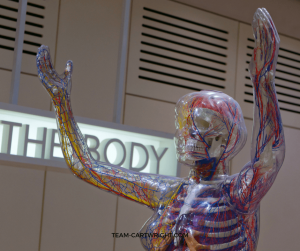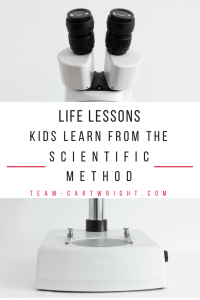Deeper than the STEM: Life lessons from the scientific method.
Does the thought of using the scientific method make you groan? I feel like it isn’t taught in a very exciting manner at school. When I first learned about it I remember it being presented more as a chore we had to go through as opposed to a valuable research tool. The thing is, it isn’t a chore. And it is so much more than just a research tool. It is a valuable system that teaches children about life. I know, that sounds dramatic. But think of the big picture lessons we want to instill in our children. Honesty, hard work, critical thinking. These are biggies. And the scientific method hits them all and more. So let’s learn about it. Here are the steps to and the life lessons from the scientific method.

What's In This Post?
What is the Scientific Method
The first question to answer is What is the scientific method? The scientific method is a system for conducting research in which a question is answered and a solution looked for in an unbiased, methodically way. The goal is to take personal opinions out of science. We want to look at the facts, at what is actually happening. What we want to happen or what we want the answer to be shouldn’t come into play.
The goal of the scientific method is to protect the integrity of research. We want to be able to find the truths behind phenomena in the world, not just what we think is happening. By using a consistent method we can have clear documentation of what happened without worry that data has been altered or changed to meet a personal need. We can test again and again to confirm results. The goal is to maintain truth and transparency.

The Parts of the Scientific Method
There are six main parts to the scientific method.
- Ask a Question
- Observe
- Form a Hypothesis
- Experiment
- Analyze Your Results
- Reach a Conclusion
Each of these steps has an important part to play in research. Following them teaches children how to work on a scientific problem. But they do so much more than that. Each step provides important life lessons. These lessons don’t stop when you walk out the classroom door.
Explore sensory STEM activities for toddlers and preschoolers!
Ask a Question
We know little kids know how to ask questions. So many questions. But asking a ton of questions isn’t the point, it is asking the right question. What specifically do we want to know? This plays into setting goals. It is way easier to reach a goal when you are specific. A goal of ‘I want to be successful’ is great, but what do you mean? Does successful mean be wealthy? Or famous? Or is just to be happy? It is much harder to achieve a goal when it isn’t clear what you are actually trying to do. Learning how to ask questions helps children really think about what they are trying to understand.
Observe
In this step, we teach kids to observe what is happening. They have identified a question they want to answer, and the first thing to do after that is to take a step back and really see what is going on. Jumping to conclusions rarely solves problems. You need to take a look at what you already know before you can take a guess as to what is happening. This is true in life too, sometimes we need to take a step back and look around. Observing also encourages kids to get out of their own heads and be in the world. We all spend too much time in our screens. Take a moment and be in the real world.

Form a Hypothesis
Here we take our best educated guess at answering our original question. This sounds easy, but it helps work a valuable life skill. Can you answer the question asked? This sort of answering encourages both critical listening and critical thinking skills. What do you think is happening? Can you take the information you have from your observations and put them together to form a real potential answer to the question? Take what you see and try your best to answer why.
Create a tasty dino dig for your kids!
Experiment
This is the fun part, you get to test out your hypothesis. Putting together an experiment works logic skills. You want to get down to the very specific nature of the question, and you need to find a way to seek out that answer. This step once again pulls out the critical thinking. You need to be able to come up with an experiment. But here’s the catch: You need to know you might fail. In science, and in life. You might set up an experiment and nail it on the first try. Often times though, you have to go back, make adjustments, and try again. Experimenting teaches kids perseverance.

Data Analysis
This is a tough part. Time to sort through that data and see what it is telling you. This step can often include a lot of math, and as you gather more and more data points some statistical analysis. But there are real-life lessons here too. Organization skills are needed to both track and then understand that data. One of the most important lessons this step works on is honesty. We’ve all heard about studies with falsified data. When that happens you can no longer trust that researcher. All her previous work becomes suspect as well. Whether you like the results or not, they are what they are. You can’t leave out data that doesn’t support your hypothesis. You can’t fudge the numbers a bit. Honesty is necessary and important for children to learn.
Form a Conclusion
After all that work you need to reach a conclusion. Was your hypothesis correct? Why or why not? What did you learn from this experiment? Sometimes we find an answer, other times we have to go back, think of a new hypothesis, and try again. But just like in the data analysis step, you need to report what actually happened. Honesty is key in that. This step works on the ability to step back and look at the big picture. You need to take everything in, apply critical thinking, and decide on a next step.

Integrity
It comes down to integrity. In science, you need to be honest and open-minded. You need to be willing to see what is happening, open to exploring potential reasons, and take an honest record of what happens. As hard as it can be sometimes, you need to be willing to admit when you were wrong or if something didn’t work. Those lessons are just as valuable as when we are right. The scientific method teaches perseverance. Things often go wrong in research. Are you going to give up? Or learn from it and try again?
An awareness of more than just yourself. Critical thinking. Observation skills. Perseverance. Honesty. Integrity. When you think of all the lessons wrapped up in the scientific method it makes it seem pretty worthwhile to share with children. Remember, you don’t need to have all the answers to do science with your kids. Not knowing is what drives the field. You just need to be willing to wonder.








